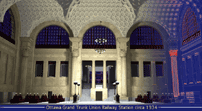|
|

| Français | Contact Us | Help | Search | Canada Site | ||||
| Home | About Us | Publications | Careers | NRC Site | ||||
| Research | People | Collaborations | Locations | What's New | ||||
| Printable version |
Computational Video
Virtual Environment Lab (VEL)
| Demos | ||||||
| ||||||
Since 1997, through the NRC Partnership in Education Program, NRC-IIT’s Virtual Environment Lab (VEL) has helped secondary and college students develop their 3D design skills. Originally assisting teachers to advance their design classes from traditional 2D design to 3D design, the lab now serves as an intermediate step to jump-start students’ careers and post-secondary education in 3D design.
Students from the National Capital Region and across Canada, have participated in the following projects launched through the VEL:
 A scene from the animation - Click for full view |
3D Reconstruction of The Commissariat at Ottawa’s Bytown Museum
The Commissariat Reconstruction Project, nicknamed the Bytown Project, began in June 2004. The Commissariat,
In the summer of 2004 a team of six students from
A second team of 3D students arrived in June of 2005 to begin work on the 3D animation. Here the team generated the realistic qualities such as sunlight, water, stone and trees. Unfortunately, there was no data on the “Pumper”, the original Steamboat Col. By and Lord Dalhousie were on. There is very little design data from that period at all on steamboats on the
The original plan was more modest than the final recreation, calling for a five minute animation with voice narration as opposed to dialogue. The addition of Colonel By and Lord Dalhousie were not in the original plan. All of the additions and the extra five minutes can be directly attributed to student enthusiasm. The result is a ten-minute tour that takes the viewer along with Lt. Colonel John By and Lord Dalhousie on the two men’s first tour of the completed locks in May 1832. This project is a clear example of how technology and history can come together to educate and entertain us.
For more information and to see the animation, please visit the project website on the Virtual Museum of Canada website.
Fort Henry Project, Kingston, Ontario
Fort Henry, constructed between 1832 and 1847, was built directly on top of the original War of 1812 fortification. Portions of this post have been revealed through archaeological investigation by Parks Canada staff, but more extensive excavation will be difficult because the present fortifications cover most of the earlier site.
In a joint effort with Parks Canada and the St. Lawrence Parks Commission, the original
 Figure A. The southeast corner of Fort Henry in the early 1820s - Click for full view |
After re-constructing the Fort in 3D, it became apparent that there may be misconceptions as to how certain features of the fort were constructed. The key was in a historical illustration (Figure A) showing the fraising (sharpened logs) to be at the top of the escarp wall at the southeast corner of the fort. Normally, the fraising would be positioned over a meter below the top of the parapet (a chest high mound of earth designed to cover troops from observation and fire).
 Figure B. The original assumption - Click for full view |
After further investigation by archaeologist Henry Cary and historian Bob Garcia (both Parks Canada staff) , they concluded that the fort’s parapet might have been reduced in height south of the west and eastern redans (triangular shaped fortifications projecting from the escarp wall) of the fort. The parapet was important on the northern, landward sides of
 Figure C. Revised model - Click for full view |
Assault from the south would have been from ships on
Our objective is to move the project to a second phase that will include more realism and analysis of this site.
 Image of the Ottawa Grand Trunk Union Railway Station circa 1934 - Click for full view |
Re-creation of The Grand Trunk Railway Union Station
The re-creation of the Grand Trunk Railway Union Station, currently known as the Government Conference Center, was completed during the summer of 2002. VEL mentored a team of college students to bring the building back in time to the mid 1930s, when it was the Grand Trunk Union Railway Station. Verified for its authenticity by local historians, the re-creation will be given to the Virtual Museum of Canada for online access.
National Arts Centre Re-creation of Performing Spaces
Students worked with National Arts Centre (NAC) staff to re-create performing spaces and to experiment with their potential uses. They conceived of an application that would incorporate the 3D reproductions in an on-line ticket purchasing system and, to that end, developed an on-line virtual 3D model of the NAC Theatre, called Virtual Theatre 1.0. Although not implemented in the NAC ticketing system, Virtual Theatre 1.0 allows users to access the replicated 3D space online and to view the stage from any seat. Students also worked with NRC-IIT researchers to develop a natural language application that enabled the design of 3D stage scenes through voice activation, rather than through 3D CAD.
Research Contact
Paul Amirault
Virtual Environment
Computational Video
NRC Institute for Information Technology
1200 Montreal Road
Building M-50, Room C-328
Ottawa, ON K1A 0R6
Telephone: +1 (613) 993-2576
Fax: +1 (613) 952-7998
E-mail: Paul Amirault
Business Contact
Dr. George Forester
Business Development Officer
Business Development Office, NCR
NRC Institute for Information Technology
1200 Montreal Road
Building M-50, Room 203
Ottawa, ON K1A 0R6
Telephone: +1 (613) 993-3478
Fax: +1 (613) 952-0074
E-mail: George.Forester@nrc-cnrc.gc.ca

|
Date Modified: 2006-03-30
|
Top of Page | |
